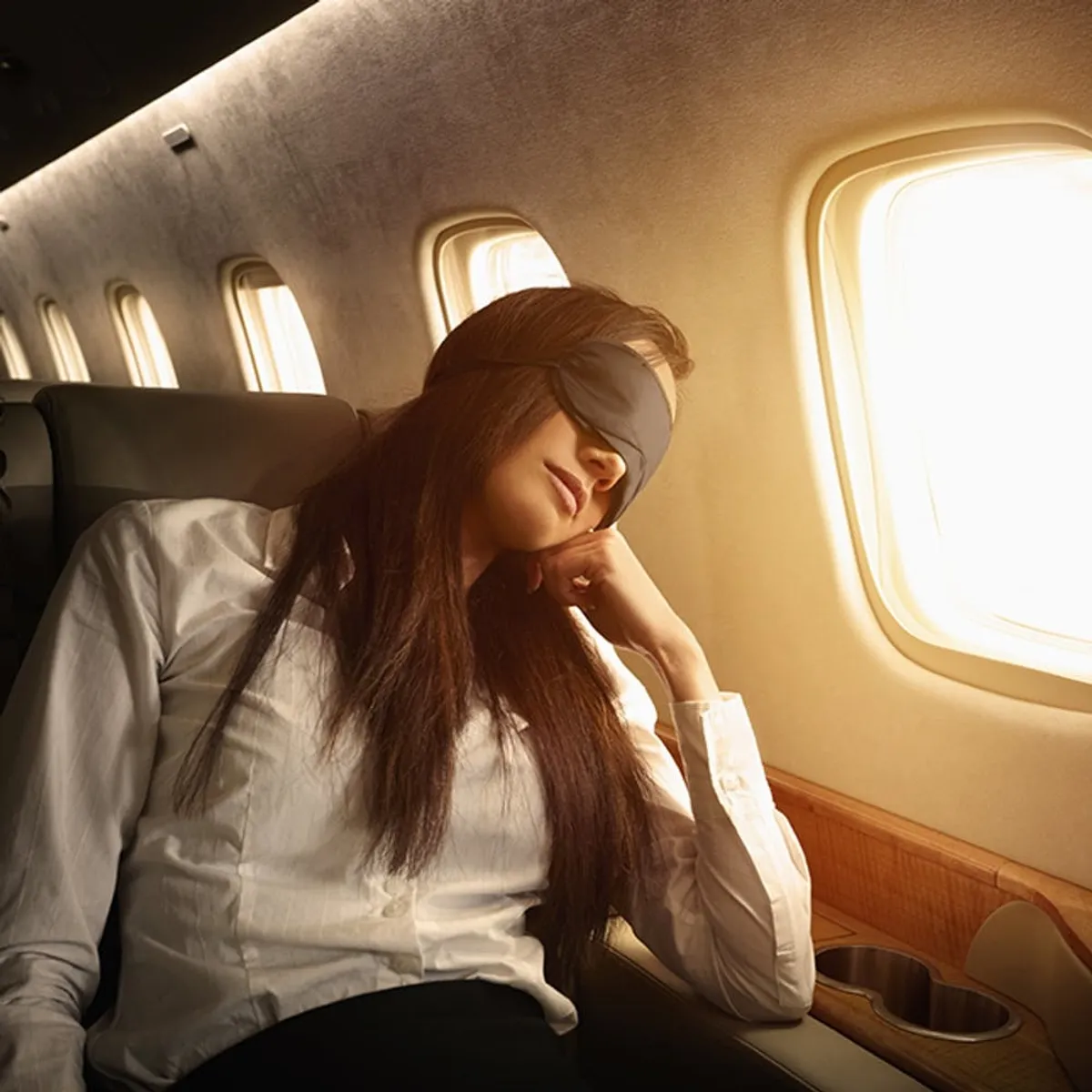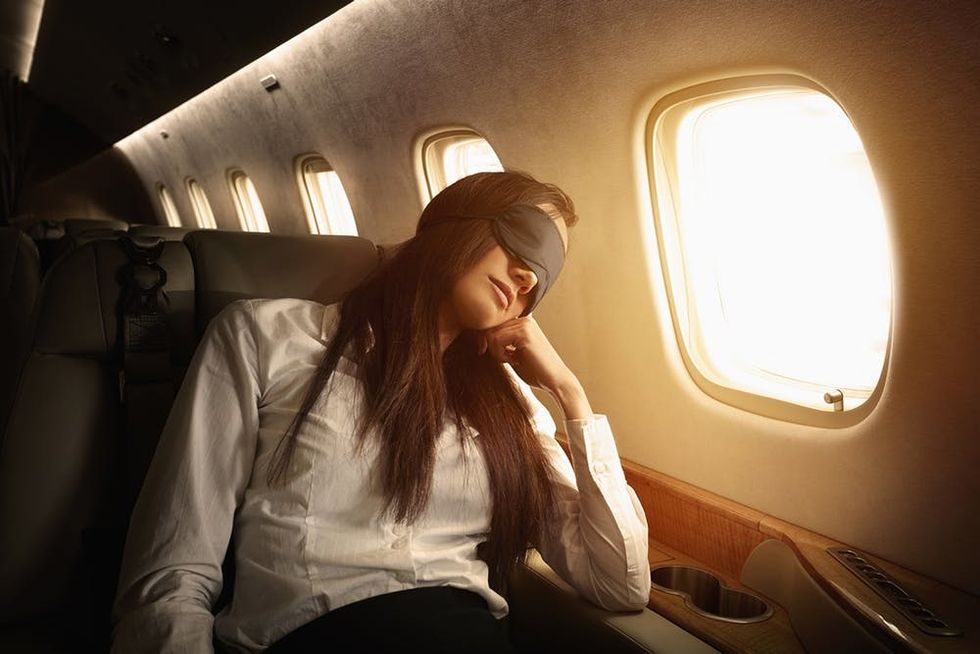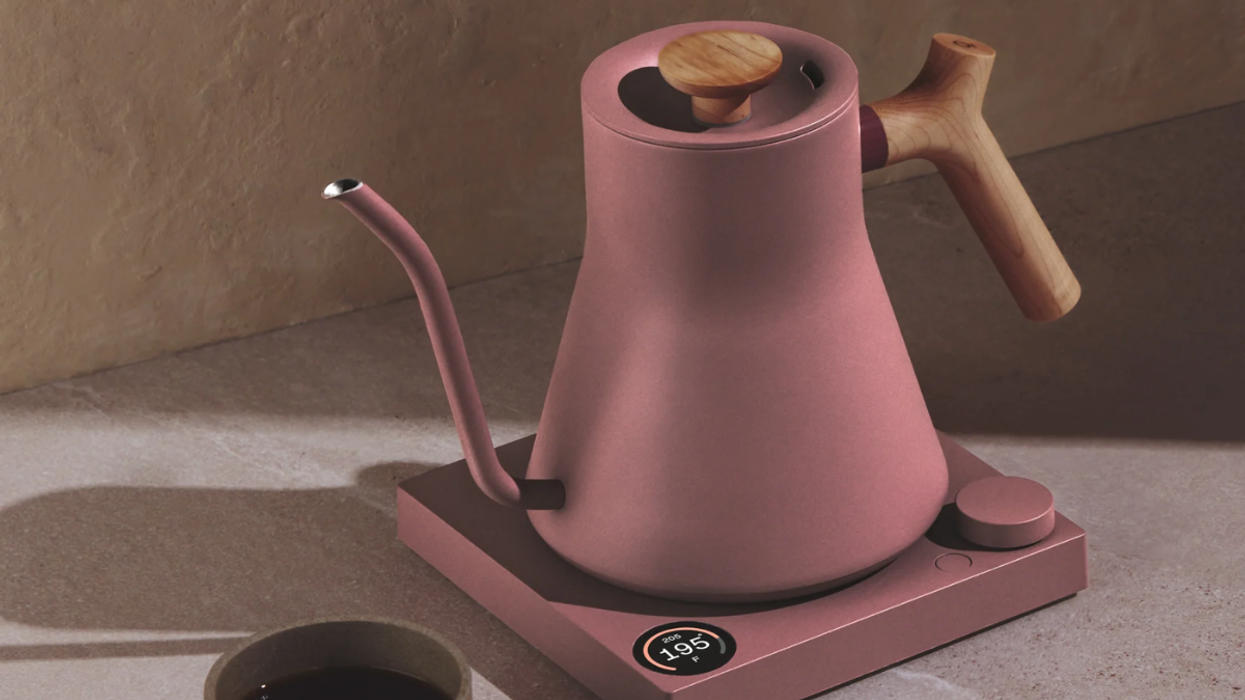Your next red-eye flight will be a total breeze.
The Ultimate Guide to Surviving Your Next Red-Eye Flight

The only thing worse than a red-eye flight is jet lag that lasts for days afterward. Feeling tired when you’re traveling isn’t just a bummer — it can leave you feeling sick or anxious, make it tough to stick with your wellness routine, or ruin a few days in a dream destination. According to Dr. Carolyn Dean, a health, nutrition, and diet expert, frequent flyer, and author, jet lag is a result of a disturbance in sleep-wake patterns. Symptoms can come from changes in air pressure during travel, and range from feeling drowsy, irritable, or lethargic to being slightly disoriented. Staying well-rested, Dean says, is your best bet for dealing on red-eye flights. “Even if you can’t sleep, rest will help decrease your travel stress,” she advises. Read on for 10 brilliant ways to rest up and beat jet-lag on your next overnight flight, once and for all.

1. Reset your sleep-wake pattern. “Stand facing the sun — make sure your eyes are protected and you are sunburn protected — for 10 to 15 minutes so that you get a healthy dose of sunlight,” Dean suggests. “This will reset your nighttime melatonin and make sure it’s not activated to make you feel sleepy during the day.”
2. Tap into the powers of magnesium and melatonin. “Magnesium is an anti-stress mineral and sleep aid that will help you relax, recover, and get a good night of sleep,” Dean explains. “It regulates melatonin production, relieves the muscle tension that can prevent restful sleep, and activates GABA, the main inhibitory neurotransmitter of the central nervous system.” Score small travel-size sealed packets of magnesium citrate powder before your long-haul trip; you can mix them with hot or cold water and sip throughout your flight.
Body positive blogger and seasoned traveler Kara Harms of Whimsy Soul told us that for her, melatonin is where it’s at. “Your body produces this hormone to regulate sleep, but you can find it over the counter for just a few bucks,” she says. “On early flights, I always pop a bit of melatonin when the flight attendant starts going over how to put on an oxygen mask. It helps me fall asleep and stay asleep for a few hours, which means I wake up feeling semi-rested.”
3. Invest in compression socks. These might not be the style statement of the year, but frequent flyers swear by wearing compression socks to stay comfortable and get good rest. They’re on to something: Poor blood circulation can cause you to feel miserable on a long-haul flight, and it can cause your feet and ankles to swell. “You don’t even notice they’re working until you go without them,” business traveler Kenny Colvin shared with us. “On one six-hour flight, which is short for me, I forgot my compression socks in my checked bag. I didn’t think it would be a big deal, but when I landed, my legs felt like tree trunks and I was exhausted — even after sleeping for three hours on the flight!”
4. Bring the right gear on your red-eye flight. Since rest is so critical when traveling during the night, bringing stuff that keeps you cozy is essential. Frequent flyers recommend you carry a blackout eye mask, noise-canceling headphones or earplugs, and a few lightweight layers. And a quality travel pillow can help you avoid waking up with a stiff neck — Krista Pappas, SVP at corporate travel company Lola, told us she swears by her Ostrich pillow ($35).
5. Wind down — without the glass of wine. Enjoying a glass of wine may be a relaxing indulgence on a normal day, but it’s best to avoid booze during your red-eye or long-haul flight. Iz Harris, vlogger and the talent behind Eater’s newest show, Travel, Eat, Repeat, explains: “Drinking alcohol on a flight is going to leave you even more dehydrated and groggy than you might have otherwise been. Skip the wine, and stick to water.”
6. Choose your seat strategically. Traveling in economy class? Hawaiian Airlines flight attendant Kaipo Kauka says to go for the window seat toward the front of the plane. “The best place to sleep is a window seat; I like using the window as something to lean on. Your seat neighbor will thank you for not leaning on them instead!” he said. “If you wake up to noise easily, stay as far from the galleys as possible. Flight attendants work in the galleys during the flight and it can get noisy. You’ll get the smoothest ride in the front of the plane. In the end, turbulence will affect the entire aircraft. Most planes tend to ‘feel’ a bit bumpier in the aft or rear section of the aircraft.”
If you truly need more room, Kauka says a first-class seat may be worth the cost. “These seats have the highest price but they do have the most legroom. Next up would be exit row seats — these rows are required to have more distance between seats to allow for easy access during an evacuation. A word of caution for exit rows, though: Whenever there are two exit rows, the forward row seats will not recline. I personally try to stay away from bulkhead seats as I prefer having a seat in front of me so I can use the area under the seat to extend my legs.”
Using TripAdvisor’s SeatGuru to lock in the best possible spot on your airplane is another pro move. Use the website or app (iOS, free) to see seats, in-flight amenities, and maps before you jet.
7. Establish a feel-good routine you can do once you land. Frequent flyer Ingrid Asoni tells us that she swears by Chinese acupuncture and Yin yoga to restore her body’s balance and feel good after a red-eye flight. “I always fit in an acupuncture appointment pre- and post-travel. Acupuncture helps to get the lymphatic system moving, which can often become blocked when our body is out of sync. It also helps to reinvigorate the body by resetting its clock to aid good, restful sleep.” Yin yoga, or a series of deep yoga stretches, is a practice that can help any physically tired traveler relax their muscles and joints. “Think of it as a rolling pin, ironing out the knots,” Asoni suggests. “You’ll sleep like a baby!”
8. Refresh your senses with essential oils. Hawaiian Airlines flight attendant Heather Sanchez says that essential oils have been part of her feel-good formula for more than 17 years. “I rely on essential oils to refresh my senses and also lavender oil, in particular, to ensure a good night’s rest,” she said. “And I find the best way to stay healthy on a red-eye or long flight is to hydrate, work out, and eat wholesome foods that are packed with nutrition and antioxidants.”
9. Adjust to a new time zone a few days before you go. Adapting to a new time zone can be tough once you land, so start preparing before you fly. Caroline Rowe of Pack the Suitcases says using a lightbox has helped her transition pre-trip: “I get into the Japanese time zone before I leave the UK by using a lightbox to trick my brain into thinking I’m in sunlight and staying up progressively later. It’s a technique I found online, but I’ve tried and tested it — it really works!”
10. Time your flights right. Arriving at your destination at night can be a wise choice if you go right to bed and wake up on local time — especially if you don’t sleep well on flights. On the other hand, it might be smart to head home during the weekend so you have time to do errands, rest up, and get back on track before going back to work.
How do you deal on a red-eye or long-haul flight? Tell us on Twitter @BritandCo!
Brit + Co may at times use affiliate links to promote products sold by others, but always offers genuine editorial recommendations.



















